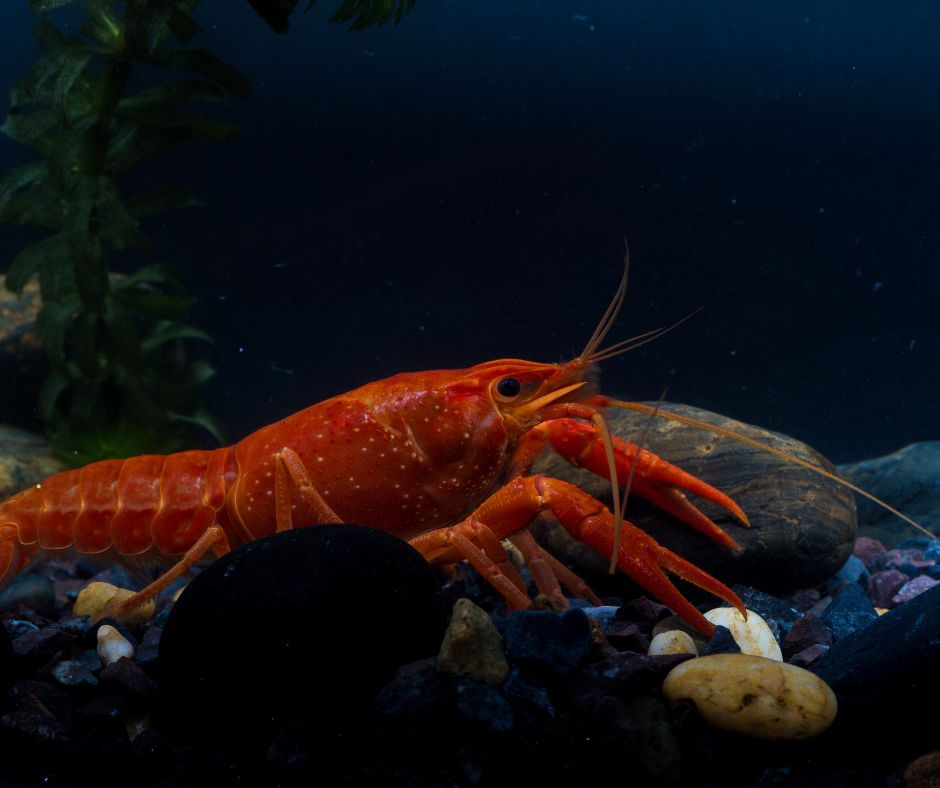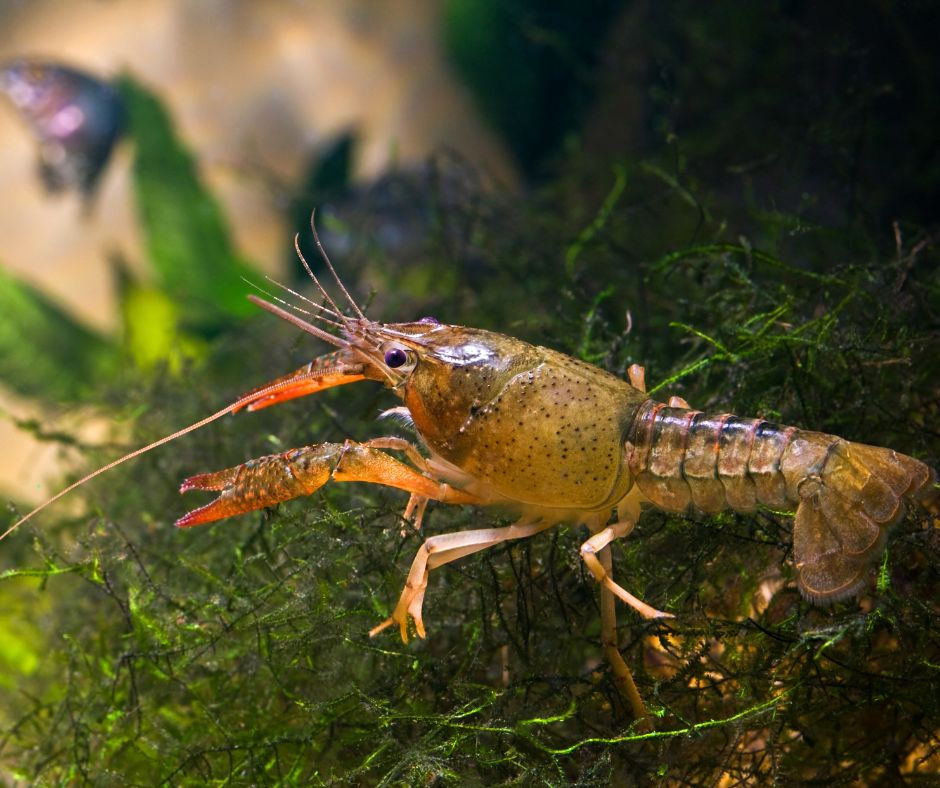How to Set Up a Crayfish Tank?
- mktpromeal
- 3 hours ago
- 6 min read

Crayfish are among the most exciting freshwater pets you can keep. They are colorful, curious, and active, but also territorial and known for being escape artists. Unlike fish, they have specific requirements for their tanks to stay healthy and stress-free. A proper setup is essential for allowing them to dig, molt, hide, and explore in a safe environment. In this guide, we will cover all the key elements that go into setting up the perfect crayfish tank.
Tank Size
One of the first decisions in crayfish care is choosing the right tank size. A single crayfish requires a minimum of 20 gallons (about 75 liters) to thrive. This size provides enough space for them to move around, establish territory, and explore. If you plan to keep more than one crayfish, you’ll need a much larger aquarium—at least 30–40 gallons (about 115–150 liters) or more—with several hiding spots to reduce aggression. Crayfish are bottom dwellers, so a long and wide aquarium is better than a tall one.
Tip: Always choose a bigger tank than the minimum. It stabilizes water conditions and reduces stress and aggression.
Substrate (Tank Bottom)

Crayfish love to dig and burrow, which makes the choice of substrate very important. The best option is fine sand or smooth gravel, which is soft and safe for their underbody. This allows them to dig naturally without the risk of injury. A depth of 2–3 inches is ideal, giving them enough material to burrow and feel secure. Avoid sharp rocks or large gravel, as these can cause cuts or discomfort.
Tip: Dark substrates not only highlight crayfish colors but also make them feel less exposed and safer.
Hiding Places & Shelter

Crayfish are territorial and vulnerable during molting, when their shells are soft. To feel safe, they need multiple hiding places in the aquarium. You can provide these with caves, clay pots, PVC pipes, driftwood, or stacked rocks. If you are keeping more than one crayfish, make sure each one has its own hiding spot, or fights will occur. These shelters reduce stress, provide protection during molting, and encourage natural behavior.
Tip: Provide at least one hiding spot per crayfish—more if possible. Extra shelters keep aggression low.
Filtration
Since crayfish are messy eaters, water quality can deteriorate quickly. A reliable filtration system is essential for keeping the water clean and safe. Canister filters and hang-on-back filters are excellent choices, but the water flow should be moderate because crayfish prefer calmer water. Strong filtration helps reduce toxins like ammonia and nitrite, keeping your crayfish healthy. Always cover the filter intake with a sponge guard to prevent small or baby crayfish from being sucked inside.
Tip: Use a filter rated for a tank size larger than yours—crayfish produce a lot of waste.
Aeration (Oxygen Supply)
Crayfish thrive in well-oxygenated water. Installing an air pump or bubbler ensures that oxygen levels remain high, especially in warmer water, where oxygen naturally decreases. Aeration also improves water circulation and prevents dead zones in the tank. While a strong filter may already provide some surface agitation, adding a bubbler offers extra security and helps create the healthiest environment possible.
Tip: Position bubblers near hiding areas to keep oxygen-rich water circulating through crayfish shelters.
Tank Lid & Escape Prevention

Crayfish are well-known escape artists. They can climb on plants, decorations, and even filter pipes to get out of the tank. A tight-fitting lid is essential to keep them inside. Always check for small gaps around wires or equipment where a crayfish might squeeze through. It’s also wise to keep the water level 3–4 inches below the top of the aquarium, which makes climbing escapes more difficult.
Tip: Treat crayfish like reptiles when it comes to security—assume they will attempt to escape every night.
Water Conditions
Stable water conditions are the foundation of crayfish care. The ideal temperature range is 65–75°F (18–24°C). Water that is too cold slows down their growth and activity, while water that is too warm causes stress. The pH level should be between 6.5 and 7.5, and medium to hard water is best for strong shell development. Perform weekly water changes of 20–25% to remove waste and toxins. Always use a water conditioner to eliminate harmful chlorine and chloramine from tap water.
Tip: Test your water weekly with a reliable kit—early detection of imbalances saves crayfish lives.
Plants in the Tank
Adding plants to a crayfish tank can be tricky. While they make the aquarium look natural and improve water quality, crayfish often nibble on them or dig them up. If you want live plants, choose hardy species such as Java fern, Anubias, hornwort, or floating plants. Artificial plants are a safe and long-lasting alternative. To prevent uprooting, always anchor live plants with rocks or plant weights.
Tip: Floating plants are safer than rooted plants, as crayfish cannot dig them up easily.
Lighting
Crayfish do not require special lighting like some fish or corals do. A standard aquarium light is enough to keep the tank visible and to support plant growth if you have live plants. Since crayfish are nocturnal, they are more active at night or in dim lighting. To mimic a natural environment, use a light timer to maintain a regular day/night cycle, which helps reduce stress and supports natural behavior.
Tip: Use dim lighting in the evening—this matches crayfish’s natural rhythm and encourages activity.
Decorations

Decorations play both a functional and aesthetic role. They enrich the crayfish’s environment and make the aquarium look attractive. Heavy decorations such as driftwood, caves, or large smooth rocks are ideal, as they provide hiding places and climbing opportunities. Avoid lightweight objects that crayfish can easily move or knock over. Ensure that all decorations have smooth edges to prevent injuries, especially during molting.
Tip: Place decorations to break line of sight—this helps reduce fights between crayfish or with tank mates.
Maintenance Tools
Keeping a crayfish tank clean requires regular maintenance. Essential tools include a gravel vacuum to remove waste and uneaten food, a water testing kit to monitor ammonia, nitrite, nitrate, and pH levels, and a water conditioner to make tap water safe. An algae scraper is also useful for keeping the tank glass clean. By having these tools ready, you can stick to a consistent cleaning schedule and prevent sudden changes that stress crayfish.
Tip: Create a weekly routine for water changes and testing—consistency keeps crayfish healthier than occasional big clean-ups.
Crayfish Tank Mates

Crayfish can live with some fast-moving fish like guppies, danios, mollies, barbs, and small schooling tetras, as these species usually stay out of reach. However, slow fish such as goldfish, bettas, and angelfish should be avoided because they are easy targets. Bottom dwellers like plecos, loaches, and Corydoras also don’t do well with crayfish since they share the same space. Snails and shrimp are seen as food, not companions, and keeping multiple crayfish together often leads to fights unless the tank is very large. For beginners, the safest option is to keep a crayfish alone in a species-only tank with plenty of hiding spots.
Tip: If you want to experiment with tank mates, always use a large aquarium and provide multiple hiding spots to reduce aggression.
Crayfish are hardy, fascinating, and highly interactive pets that can bring endless excitement to your aquarium. With the right tank size, proper substrate, secure hiding places, and stable water conditions, they will thrive and display their natural behaviors like digging, climbing, and molting. While some fast fish may coexist with them, crayfish are best enjoyed in their own species-only tank, especially for beginners. By giving them a secure home with clean water, a balanced diet, and enough space, you ensure that your crayfish will live a long, healthy, and active life—becoming the true centerpiece of your aquarium.
At Promeal, we know how important it is to give your pets a healthy and varied diet. That’s why we create high-quality, natural pet food to keep them happy and healthy.
Our specialty is premium live and dried insect-based feeds like mealworms, superworms, crickets, roaches, waxworms, and hornworms. These insects are grown on an organic diet, making them a nutritious and tasty treat for your pets.
Check out our "Shop" section to find the perfect food for your pets!




Comments